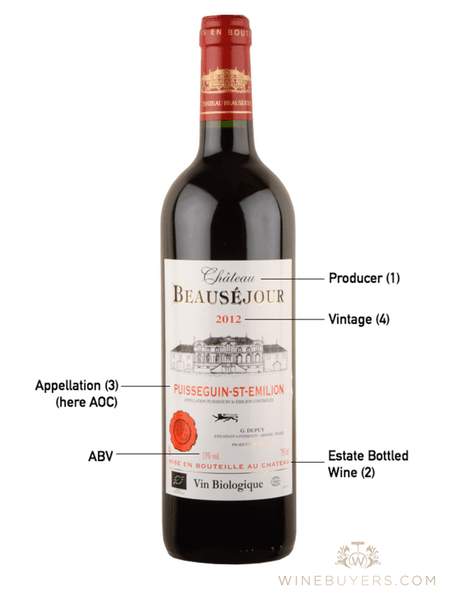If you’ve ever picked up a bottle of wine and started to read the label only to be confused by what is written there, you’re not alone. Wine labels can be difficult to understand, especially if you’re looking for something to complement a particular meal or want to become something more of a connoisseur. To help you out, here’s our quick guide and handy diagram to reading wine labels.
It’s like a book jacket description
The information on the wine label is designed to give you an idea of what the bottle contains. While some of this can be useful, you have to take other information with a little pinch of salt. Details such as the origin and alcohol content or ABV are usually contained on the front label but some of the most interesting stuff is included on the back, if you can get past the marketing spiel.

The Producer (1)
All the top wineries have a brand and taste that sets them apart from their competitors. If you are looking for a quality product, you will want to know that the producer has grown the grapes and bottled the wine on a particular estate (2).
Other wines can be fermented elsewhere or use grapes from different regions. The general consensus is that wines made completely on a certain estate are of better quality but it’s not always the case. Provenance is always a key factor in wine choice so learning more about the different producers and wineries should be top of you list of things to do.
The type of wine (3)
The label will also include details of what type of grape has been used in the wine production. It can include an origin area such as St Emilion or Chianti, so you need to understand what grape varieties are grown in these regions. This is more often the case for old-world wines or traditional wine making regions as opposed to new vintages or wineries around the world. Different countries have their own specific ways of labelling. In the case of our diagram, French wine will contain an indication of the wine’s quality as there are more controls and restrictions compared to other regions.
That’s why you often see the phrase appellation d’origine controlee (AOC) which is used to certify high quality wines in the country. Where the grapes were grown will also be shown on the label and this can be somewhere as big as state like California or much more specific such as the area around a town. There’s a generalised view that the more specific the location, the higher quality the wine but that can’t always be taken for granted.
Vintage or Non-Vintage (4)
The vintage is the year during which the grapes in the wine were harvested. This can often be misleading for consumers as it can mean different things depending on the wine. When the grapes were harvested can point to the quality of the vintage though this is not relevant for many areas. It’s a more important factor if you are buying wine as an investment rather than for enjoying at an evening meal. Multi-vintage wines (often labelled as NV) tend to be lower value wines as they have the ability to control the flavour by pulling wine from different vintages.
Wine production
There are a variety of different ways that wines are produced that can pop up on the wine label. You might, for example, come across wines made from ‘old vines’ which can be an indication that the vintage contains more flavour. Be wary as there is often little regulation across regions when it comes to descriptive factors such as this.
Old vines can be anything from 15 to 150 years old. 'Reserve' is another description that sounds good on the surface as it suggests the wine meets certain higher standards. In Spain and Italy there are regulations which means the wine has to be aged for a certain period of time. Be aware of unregulated new world wines where the term 'Reserve' can equally (but not always) be used as a selling point and mean nothing.
Look past the label and uncork
While the label on a bottle of wine can tell you a lot, you also need to separate the important information from the marketing ploy. What will really tell you whether a wine is good or not, however, is the taste. The only sure way to check if it’s for you or not is to look past the label and uncork the bottle.
What are you going to try next? Check out our great wine collection today to discover new wines.


:fill(white):fill_transparent()/sylius_prod/blog/direct-from-vineyard-menu.png)
:fill(white):fill_transparent()/_static/mega-menu/spirits-direct-from.png)
:fill(white):fill_transparent()/_static/mega-menu/offers-best-wine-and-spirits-deals.png)
:fill_transparent()/sylius_prod/blog/how-to-read-wine-labels.png)
Thanks for the excellent article